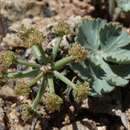Comprehensive Description
provided by North American Flora
Cymopterus basalticus M. E. Jones, Contr W. Bot. 12: 16. 1908.
Coriophyllus basalticus Rydb. Fl. Rocky Mts. 620, 1064. 1917. Aulospermum basallicum Tidestrom, Contr. U. S. Nat. Herb. 25: 397. 1925.
Plants acaulescent or subcaulescent with the development of an inconspicuous pseudoscape, 6-12 cm. high, glabrous, bluish-glaucous throughout; leaves ovate-oblong in general outline, excluding the petioles 0.5-3 cm. long, 1.5-3.5 cm. broad, reniform to cordate-oblong, ternate or digitate, the leaflets shallowly lobed, cuneate to obovate, more or less confluent, the lobes trilobulate; petioles 1-5 cm. long; peduncles usually exceeding the leaves, 3-10 cm. long; involucre wanting, or of 1 or 2 linear-attenuate, subscarious bracts; involucel conspicuous, dimidiate, of several linear to obovate, attenuate, subscarious bractlets, entire or lacerate toward the apex, usually equaling or exceeding the flowers; fertile rays 7-14, spreading to reflexed, stout, 5-17 mm. long; pedicels obsolete; flowers yellow or purplish; fruit ovoid, 3-5 mm. long, 3-4 mm. broad, the wings slightly enlarged toward the base, the dorsal wing usually one; oil-tubes 6-8 in the intervals, 8-10 on the commissure, usually 1 in the wing-base; seed-face slightly concave.
Type locality: "Half-way station west of WaWa, Utah, 7000 feet alt.," M. E. Jones. Distribution: Western Utah and adjacent Nevada {Harrison 6370).
- bibliographic citation
- Albert Charles Smith, Mildred Esther Mathias, Lincoln Constance, Harold William Rickett. 1944-1945. UMBELLALES and CORNALES. North American flora. vol 28B. New York Botanical Garden, New York, NY
Cymopterus basalticus: Brief Summary
provided by wikipedia EN
Cymopterus basalticus is a species of flowering plant in the carrot family known by the common name Intermountain wavewing. It is native only to parts of Utah and White Pine County, Nevada in the United States. It is a perennial herb, 5 cm (2.0 in) to 15 cm (5.9 in) tall, and produces purple or yellow flowers in spring. C. basalticus grows on bare basaltic and clay soils typically in pinyon-juniper woodland and sagebrush communities.
- license
- cc-by-sa-3.0
- copyright
- Wikipedia authors and editors

